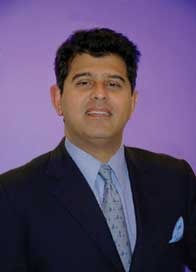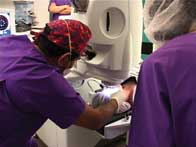Centre for Sight was established in 1996 by consultant ophthalmic surgeon Sheraz Daya. Located in the Corneo Plastic Unit and Eye Bank at the East Grinstead-based Queen Victoria Hospital, the centre offers a wide range of services including cataract surgery, glaucoma care, corneal transplantation and oculoplastic surgery.

'I am very proud to tell you that CFS is now just over 10 years old,' says Daya. 'We started out in October 1996 and did our first procedure in early 1997.'
Daya commenced refractive surgery in 1990 and was attracted to ophthalmology after he saw his first cataract and IOL procedure as a medical student on ophthalmology rotation in 1982. After completing training in ophthalmology in New York City, he trained in cornea and refractive surgery in Minneapolis, Minnesota. 'I always wanted to do something surgical and I realised that ophthalmology was perfect as it was high-tech, skilful, satisfying for patients and the surgeon and also dignified as we operate sitting down,' he says.
Daya manages 20 staff over the two centres in London, where consultations and diagnostics take place, and East Grinstead, where the surgery is also performed. The staff base includes three surgeons, five clinical staff, managers and administrative support.
What is instantly noticeable at the East Grinstead centre is the professional, but laid-back attitude of the staff, which helps to puts nervous patients at ease. Daya says a typical day begins at 8.30am and ends around 7-8pm. He carries out refractive surgery on 15 to 20 patients a day, equating to 30 to 40 procedures.
The patient journey begins with a brief private consultation before being asked to wait for a short time outside the operating room. A large screen displays a live film of the patient ahead of them undergoing surgery. This shows the surgeon's view of the eye as the refractive surgery is carried out.
While this may prove alarming to some, it is also undeniably fascinating to watch the speed and simplicity with which the procedure is carried out. It is also reassuring that the surgical team are so confident about their abilities and the safety of the procedure that it is viewable to all.
In the theatre, and just prior to the procedure, the patient lies on the operating table and topical anaesthetic drops are applied while the area around the eye is cleaned and an eyelid holder positioned. Daya speaks calmly and reassuringly to the patient throughout the procedure.

A 60Khz Intralase laser takes just over 15 seconds to create a flap at a specified depth in the cornea. The laser creates condensed bubbles to make the flap edge. Centre for Sight is a reference site for both Bausch & Lomb and Intralase and, after lifting the flap, Daya uses the B&L 217 Z100 excimer laser to reshape the cornea. He asks the patient to watch a flashing red light throughout the procedure to keep their eyes correctly positioned. After treatment is completed the flap is replaced and allowed to dry. The procedure typically takes around five minutes for each eye.
After surgery, the patient is instructed to wear protective, dark goggles and keep the eyes shut, while being guided to a waiting room to let the eyes settle. After a final check, the patient is allowed to leave with instructions to wear the goggles for 24 hours and at night for the next four weeks.
Over lunch, a relaxed Daya discusses his views about the role of optometrists in refractive surgery. 'I think it is very important for optometrists to counsel patients who are interested in refractive surgery and refer them to the right clinics. Optometrists care about their patients and certainly want to ensure they receive the best care available. The only way optometrists are going to know where good care is provided is by visiting the centres,' he says.
'I don't think that practitioners should be paid for referring but they should for performing a consultation either by the centre or by the patient, depending on what is performed at the consultation.
'I understand optometrists are busy but think they should set aside time and should be seeing the surgeons. Associating with laser eye surgery centres is a practice booster and professionals shouldn't fear losing their patients. They will be back to buy presbyopic correction and sunglasses they previously couldn't afford and what's more they will bring their whole family to the practice.'
'Intralasik really does revolutionise refractive surgery and optometrists need to see it in action,' he continues. 'They should look at laser surgery as an investment for the future and try to come to an arrangement with a good provider and involve themselves in the patient care pathway.'
Daya says that his future plans are to continue to grow the business and to maintain high standards of care. 'We pride ourselves in providing among the best care available in the UK and do not compromise in terms of technology or standards.' In addition, he has just received planning permission to build a surgical eye centre on the outskirts of East Grinstead, which he says will be among the most modern private eye care facilities in Europe.
Daya's enthusiasm and passion for refractive surgery is unmistakable and, while he admits his day is long, he says that 'performing surgery and sharing in the phenomenal joy experienced by patients' makes it a pleasure. ?
